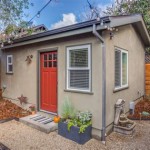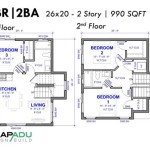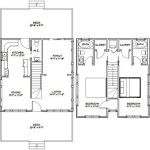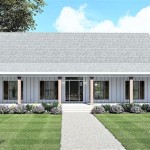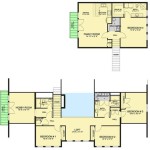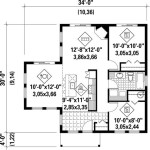The Enduring Appeal of Open Floor Plan Living Room Kitchen Combinations
The open floor plan, a design concept characterized by the removal of walls to create expansive, interconnected living spaces, has become a dominant trend in residential architecture. Combining the living room and kitchen into a single, unified area offers a myriad of aesthetic and functional advantages, contributing to a more social, versatile, and visually appealing home environment. This article explores the key benefits and practical considerations associated with open floor plan living room kitchen designs.
Enhanced Social Interaction and Family Connectivity
One of the most significant advantages of an open floor plan is its ability to foster greater social interaction within the home. The absence of physical barriers between the living room and kitchen allows family members and guests to engage in conversations and activities regardless of their location within the space. While someone is preparing a meal in the kitchen, they can easily interact with individuals relaxing in the living room, creating a sense of togetherness and shared experience. This design is particularly beneficial for families with young children, as parents can supervise children playing in the living area while simultaneously managing cooking responsibilities.
Traditional floor plans often isolate the kitchen, traditionally considered a workspace, from the more social areas of the house. This separation can lead to feelings of isolation for the cook, especially during gatherings. An open floor plan eliminates this isolation, allowing the person preparing food to remain an active participant in the social atmosphere. Guests are also more likely to feel comfortable congregating in the kitchen area, contributing to a more relaxed and informal atmosphere. The open flow also encourages collaborative cooking experiences, as multiple individuals can comfortably assist in meal preparation without feeling cramped or confined.
The impact extends beyond immediate family. When hosting parties or gatherings, an open floor plan allows for seamless flow between the kitchen and living area, facilitating conversation and movement among guests. The host can easily prepare food and drinks while remaining engaged with their guests, creating a more welcoming and inclusive environment. The open space also provides ample room for guests to mingle and interact, preventing the feeling of congestion often associated with smaller, more compartmentalized rooms.
Increased Natural Light and Improved Spatial Perception
Beyond social advantages, open floor plans significantly enhance the natural light distribution within a home. The removal of interior walls allows sunlight to penetrate deeper into the space, creating a brighter and more inviting atmosphere. This is particularly beneficial in homes with limited window placement or those located in areas with lower levels of natural light. The increased natural light reduces the need for artificial lighting during the day, contributing to energy savings and a more sustainable living environment.
The improved spatial perception is another crucial advantage. Open floor plans create a sense of spaciousness and openness, making a home feel larger than its actual square footage. The uninterrupted sightlines across the living room and kitchen create a more expansive and airy atmosphere, which can be particularly appealing in smaller homes or apartments. This increased sense of space can also contribute to a feeling of relaxation and well-being, as individuals are less likely to feel cramped or confined.
Careful consideration of window placement is critical in maximizing the benefits of natural light within an open floor plan. Large windows or sliding glass doors facing south or west can bring in significant amounts of sunlight during the day. Skylights can also be strategically placed to provide additional natural light to interior areas. It's essential to balance the benefits of natural light with considerations for heat gain and glare, especially in warmer climates. Proper window treatments, such as blinds or curtains, can help control the amount of sunlight entering the space and prevent overheating.
Multi-Functional Design and Enhanced Versatility
Open floor plans are inherently versatile, allowing for a wide range of activities and uses. The combined living room and kitchen space can easily adapt to different needs and lifestyles. The area can function as a gathering space for family and friends, a workspace for home offices, or a play area for children. The flexible layout allows for the effortless rearrangement of furniture and accessories to suit different occasions and activities.
The multi-functional nature of an open floor plan makes it ideal for entertaining. The kitchen island can serve as a central hub for food preparation, while the surrounding living area provides ample space for guests to mingle and relax. A large dining table can be placed adjacent to the kitchen island, creating a seamless transition between cooking and dining. The open layout allows the host to easily interact with guests while preparing and serving food, creating a more engaging and interactive dining experience.
In addition to entertaining, open floor plans can also accommodate a variety of other activities. A designated corner of the living area can be used as a home office, providing a comfortable and functional workspace. The kitchen island can also serve as a temporary workspace for quick tasks or homework. The open space can also be easily transformed into a play area for children, allowing them to engage in activities while remaining within sight and earshot of their parents. The versatility of an open floor plan makes it an ideal choice for individuals and families with diverse needs and lifestyles.
Furthermore, the resale value of homes with open floor plans, particularly those integrating the living room and kitchen, tends to be higher than those with traditional, compartmentalized layouts. This increased value reflects the modern aesthetic and functional benefits that prospective buyers appreciate. The open design appeals to a wider range of buyers, making it a desirable feature in the real estate market. Renovating an existing home to incorporate an open floor plan can be a worthwhile investment that significantly enhances its value and appeal.
However, it's important to consider the potential drawbacks of open floor plans. Noise can travel easily in an open space, which can be disruptive for individuals who are sensitive to sound. Cooking smells can also permeate the entire area, which may be undesirable for some homeowners. A lack of privacy can also be a concern, as there are no physical barriers separating the living room and kitchen. These potential drawbacks can be mitigated by careful planning and design considerations. Soundproofing materials can be used to reduce noise transmission, and high-quality ventilation systems can help to remove cooking smells. Strategic placement of furniture and accessories can help to create visual barriers and define distinct zones within the open space, providing a sense of privacy and separation.
Ultimately, the decision of whether or not to incorporate an open floor plan living room kitchen design depends on individual preferences and lifestyle considerations. By carefully weighing the benefits and drawbacks, homeowners can make an informed decision that best suits their needs and enhances their living experience. A successful open floor plan design requires careful planning, attention to detail, and a thorough understanding of the principles of interior design. When executed properly, it can create a beautiful, functional, and inviting space that enhances the quality of life for all who inhabit it.
Careful consideration of furniture placement, lighting design, and material selection is essential for creating a cohesive and functional open floor plan. Furniture should be arranged to define distinct zones within the space, such as a seating area in the living room and a dining area adjacent to the kitchen. Lighting should be layered, with a combination of ambient, task, and accent lighting to create a warm and inviting atmosphere. Materials should be chosen to complement each other and create a unified aesthetic. The kitchen cabinetry, countertops, and backsplash should coordinate with the flooring, wall colors, and furniture in the living area. The goal is to create a seamless and harmonious transition between the different zones within the open space.
The integration of the living room and kitchen also presents unique challenges and opportunities in terms of design and functionality. It's crucial to ensure that the kitchen design complements the overall aesthetic of the living area and that the two spaces function together seamlessly. Thoughtful space planning, appropriate furniture selection, and consistent design elements are essential for creating a cohesive and enjoyable open floor plan.
:strip_icc()/Open-concept-living-room-TWP0380-CV1hghhEaBBAkX_uv8K9cw-3313dfd39e2b42f5b37f43b8dfa14e08.jpg?strip=all)
Pros And Cons Of Open Floor Plans 5 Things To Consider
:max_bytes(150000):strip_icc()/MCH_6778-ad1a2ad1a91f4a9fa1747fe72be5a1d9.jpg?strip=all)
35 Open Floor Plan Decorating Ideas Designers Love For Great Flow

Open Concept Kitchen Living Room Design Inspirations

Open Floor Plan Kitchen Living Room

Pros And Cons Of Open Concept Floor Plans

Before After Contemporary Open Concept Living Room And Kitchen Decorilla Interior Design

Open Concept Kitchen Living Room Photos Ideas Houzz

50 Open Concept Kitchen Living Room And Dining Floor Plan Ideas 2024 Ed

30 Open Concept Kitchens S Of Designs Layouts

How To Make An Open Floor Plan Feel More Cozy The Seattle Times

